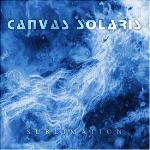Kollege Memme ist in seinem Review zum Vorgänger "Penumbra Diffuse" bereits erschöpfend auf den sehr frickeligen, etwa an VOIVOD, WATCHTOWER und PSYCHOTIC WALTZ angelehnten Sound des Quintetts (auf de
Band:
BiografieCanvas Solaris Mark 1: Canvas Solaris first appeared in the fall of 1999, under the name Pikkmon´s Model. The Trio, then comprised of the Jimmy McCall (bass guitars), as well as current members Nathan Sapp (guitars, vocals) and Hunter Ginn (drums), the music produced by this early incarnation bears little resemblance to Canvas Solaris circa 2004. The trio´s early sound can best be described as an amalgam of Necroticism-era Carcass, Voivod, Godflesh-like noisemongering, third eye-stimulating psychedelia, and the hyperactive riffing of Brutal Truth´s Need to Control opus. After playing a number of local and out of town shows, the group finally committed their songwriting efforts to tape in late March 2000. The session, recorded at Phoenix Sound Studios in Macon, Ga., yielded the songs "ChaosGraft", "Echo Dimension", "A Wind of Flame", and the progressive standout, "Spaces Between Dreams". This track, with its dizzying meters, jarring dynamics, and sonic quirks, foreshadowed the unique sound that Canvas Solaris would explore over the next 1 ½ years. Canvas Solaris
Over the next 6 months, the group continued to play live shows and craft new material, which showed an ear cocked toward the avant-garde leanings of "Spaces". In late 2000, the group, now officially known as Canvas Solaris, recorded their second demo. Though still largely dissonant and aggressive, the band´s new music demonstrated a significant maturity. The demo´s longest track, the oddly-titled "Adequate Intentional Misuse", vacillated between outright cacophony and shimmering psychedelia (provided by guest guitarist Andy Jones). The demo also displayed a nascent melodicism, most obvious in the beautiful ending sections of "Essence Burns Black" and "Descent from Sidereal". The latter track also displayed an unprecedented level of technicality, and is the first track to point toward the future sound of Canvas Solaris.
In May 2001, the group was joined by local vocalist Brad Jeffcoat, who relieved Sapp of the lion´s share of his vocal chores (though the guitarist continued to augment the sound with his raspy vocals). Shortly thereafter, Sapp came into contact with ex-Metal Maniacs editor Jeff Wagner, who was impressed by the group´s unique songwriting efforts, and who encouraged the band to continue to explore their original ideas. Later that year, the group re-entered Phoenix Sound to record their best and most mature track to date, "The Flesh Sequence". This song finally capitalized on the potential the group had only suggested up to this point. Following this track´s completion, the band pressed up an official demo, aimed at generating label interest. Containing the tracks "Spaces Between Dreams", "Descent From Sidereal", and "The Flesh "Sequence", the demo turned several heads and impressed listeners, garnering rave reviews in respected publications such as Worm Gear and Snakepit. Labels, however, were kept at bay by the strangeness of the group´s songs.
This hardly discouraged the band, however. These rejections instead led them toward their ultimate destination, the untilled fields of instrumental tech-metal. Following the departures of McCall and Jeffcoat in May 2002, the group added guitarist/bassist/keyboardist Ben Simpkins to the line-up, and began writing new, more challenging material.
Canvas Solaris Mark 2: By June 2002, the group was beginning to work on a handful of new compositions, one of which, "Flux and Ekstasis", had been performed with McCall and Jeffcoat. Canvas Solaris´s new songs blended uncompromising technicality with the soaring melodicism of the "The Flesh Sequence". These songs gave further emphasis to clean, jazz-inspired sections, aided by Sapp´s newly-purchased Roland guitar synthesizer. Armed with four brand new compositions, the band entered Phoenix Sound (at its new location in Greenville, SC) to record a new demo. This collection quickly caught the ear of Tribunal Records president Matt Rudzinski, who expressed tremendous interest in releasing the demo on his label. The band agreed, and in June 2003, Tribunal released Spatial/Design to rave reviews and general confusion.
Ever the workhorses, Canvas Solaris continued to write new songs, which demonstrated a remarkable improvement over the Spatial compositions. The group scaled back their live appearances greatly, playing only 2 shows in 2003. Instead, Canvas continued to work on their polished new songs. In January 2004, the group entered The Basement Studios in Winston-Salem, NC, with producer Jamie King (Between the Buried and Me, Darkness Remains). Finally, Canvas Solaris were afforded the rich production that their songs deserve. The resulting piece of music, Sublimation, forges new sound paths for the band, with songs such as "When Solar Winds Collide" and "Syzygial Epiphany" demonstrating an unusually melodic/progressive direction. The album is scheduled for release in July 2004, and as this is being written, the band are in the final stages of writing for their next album, which they assure us will be a far wilder, more diverse work than Sublimation.
Quelle: http://www.canvassolaris.net/Discografie2000 - Demo I
2000 - Demo II
2001 - Promo (Demo)
2003 - Spatial/Design (EP)
2004 - Sublimation
2006 - Penumbra Diffuse
2007 - Cortical Tectonics
2008 - The Atomized Dream
2010 - Tribute To Coroner (Split)
2010 - Irradiance
www
Reviews
Die Instrumental-Könner CANVAS SOLARIS aus Georgia, USA veröffentlichen mit „Irradiance“ bereits ihr fünftes Album, auf dem erneut aberwitzige Achterbahnfahrten aus flottem Artrock und auc
Harter Tobak aus Georgia: Die drei Jungs spielen absolut progressiven Rock-Metal, an dem Freunde von Watchtower und Co.KG sicherlich jede Menge Gefallen finden werden.
CANVAS SOLARIS sind drei Amis aus Georgia welche der extrem technischen Variante des gefrickelten Progs frönen.








